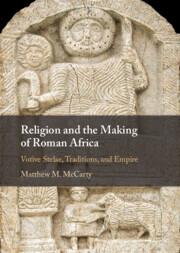Book contents
- Religion and the Making of Roman Africa
- Religion and the Making of Roman Africa
- Copyright page
- Contents
- Figures
- Tables
- Acknowledgments
- Abbreviations
- Part I Colonial Histories
- Part II Themes in the Making of Hegemony
- 3 Making Africa with Punic Signs
- 4 Making a God
- 5 Making Sanctuary Communities
- 6 Making Children Subjects of Empire
- 7 Making Offerings
- 8 Remaking Spaces and Societies
- 9 Making Empire
- Book part
- References
- Index
4 - Making a God
from Part II - Themes in the Making of Hegemony
Published online by Cambridge University Press: 24 October 2024
- Religion and the Making of Roman Africa
- Religion and the Making of Roman Africa
- Copyright page
- Contents
- Figures
- Tables
- Acknowledgments
- Abbreviations
- Part I Colonial Histories
- Part II Themes in the Making of Hegemony
- 3 Making Africa with Punic Signs
- 4 Making a God
- 5 Making Sanctuary Communities
- 6 Making Children Subjects of Empire
- 7 Making Offerings
- 8 Remaking Spaces and Societies
- 9 Making Empire
- Book part
- References
- Index
Summary
This chapter challenges the supposed transformation “from Baal Hammon to Saturn” in North Africa one of the chief grounds upon which narratives of cultural continuity are predicated. It argues that instead of simple syncretism or the persistence of a god, the material signs used to construct and identify the deity to whom stelae were dedicated underwent important transformations in the second and third centuries CE, changes closely tied to the experiences and practices of empire. Stelae of the third and second centuries BCE made a god present indexically; stelae of the imperial period embraced iconicity in ways that were entangled with empire, including new divine epithets tied to imperial authority and new road systems in the province. And by the end of the second century CE, this iconic system could even work to perpetuate clear social hierarchies.
- Type
- Chapter
- Information
- Religion and the Making of Roman AfricaVotive Stelae, Traditions, and Empire, pp. 115 - 175Publisher: Cambridge University PressPrint publication year: 2024

